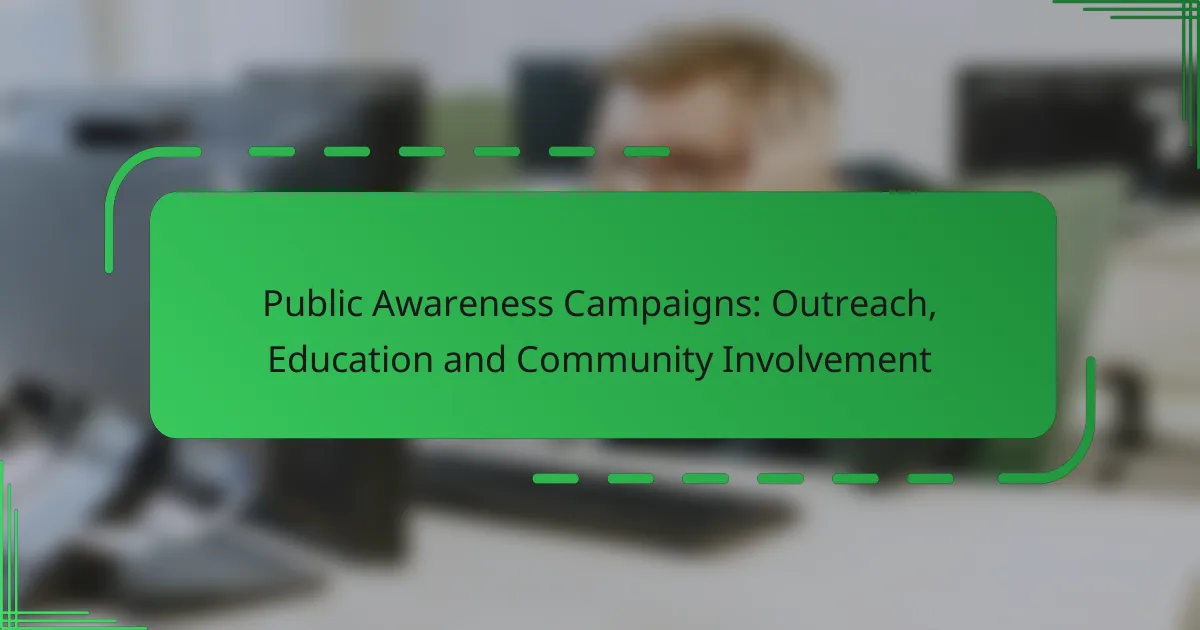Community engagement programs are essential for fostering collaboration and participation among residents, enhancing communication and trust within the community. By empowering individuals to take part in local decision-making, these programs not only improve public services but also strengthen community ties, creating a sense of belonging. Measuring the outcomes of these initiatives through both quantitative and qualitative methods provides valuable insights into their effectiveness and impact.
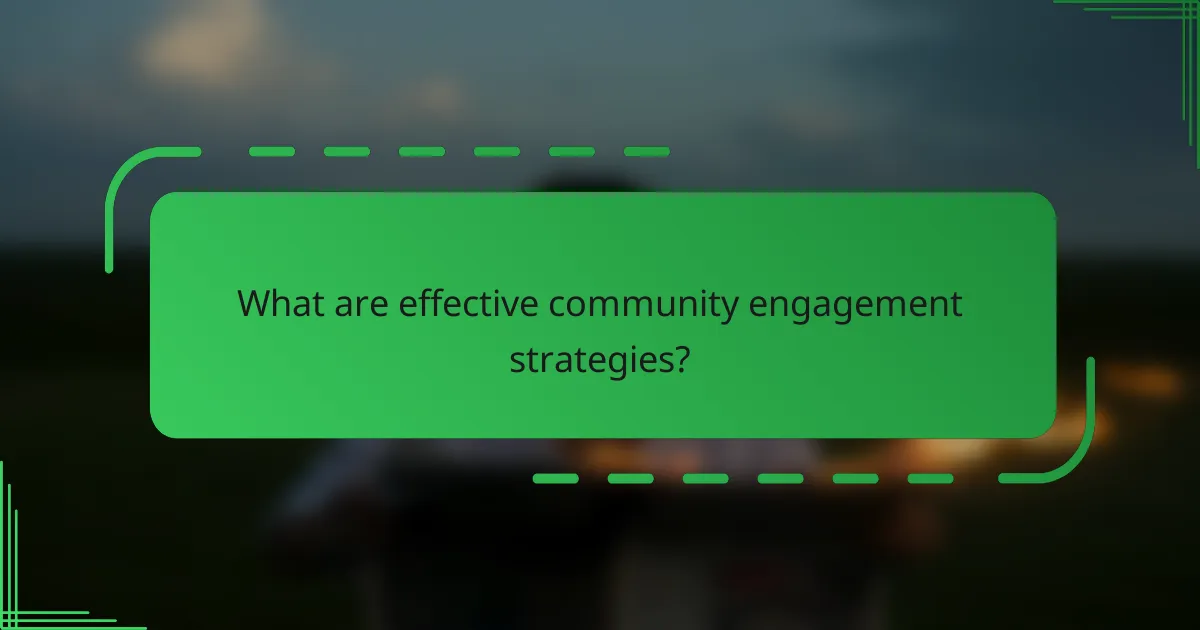
What are effective community engagement strategies?
Effective community engagement strategies involve methods that foster participation and collaboration among community members. These strategies aim to enhance communication, build trust, and empower residents to contribute to local decision-making processes.
Participatory budgeting
Participatory budgeting allows community members to directly influence how a portion of the public budget is spent. Residents propose and vote on projects, ensuring that funding aligns with their needs and priorities. This method promotes transparency and accountability in financial decisions.
To implement participatory budgeting, local governments should establish clear guidelines and timelines for the process. Engaging diverse community groups is crucial to ensure broad representation and avoid skewed outcomes.
Community workshops
Community workshops are interactive sessions where residents can discuss issues, share ideas, and collaborate on solutions. These workshops can focus on specific topics, such as urban development or public health, and are designed to gather input from various stakeholders.
When organizing workshops, consider the venue, time, and accessibility to encourage participation. Providing materials and refreshments can also enhance engagement and create a welcoming atmosphere.
Online forums
Online forums offer a platform for community members to discuss issues, share resources, and connect with one another. These digital spaces can facilitate ongoing conversations and reach individuals who may not attend in-person events.
To maximize effectiveness, ensure the forum is user-friendly and moderated to maintain a respectful environment. Regularly updating content and encouraging participation through prompts or questions can keep discussions active.
Volunteer programs
Volunteer programs mobilize community members to contribute their time and skills to local initiatives. These programs can address various needs, from environmental clean-ups to tutoring services, fostering a sense of ownership and pride among participants.
To create a successful volunteer program, clearly define roles and expectations. Providing training and recognition for volunteers can enhance retention and satisfaction, making the program more sustainable.
Social media campaigns
Social media campaigns leverage platforms like Facebook, Twitter, and Instagram to engage the community and spread awareness about local issues. These campaigns can be used to inform residents, promote events, and encourage participation in community activities.
Effective social media campaigns should have clear objectives and target specific audiences. Utilizing visuals and interactive content can increase engagement, while regular updates help maintain interest and momentum.
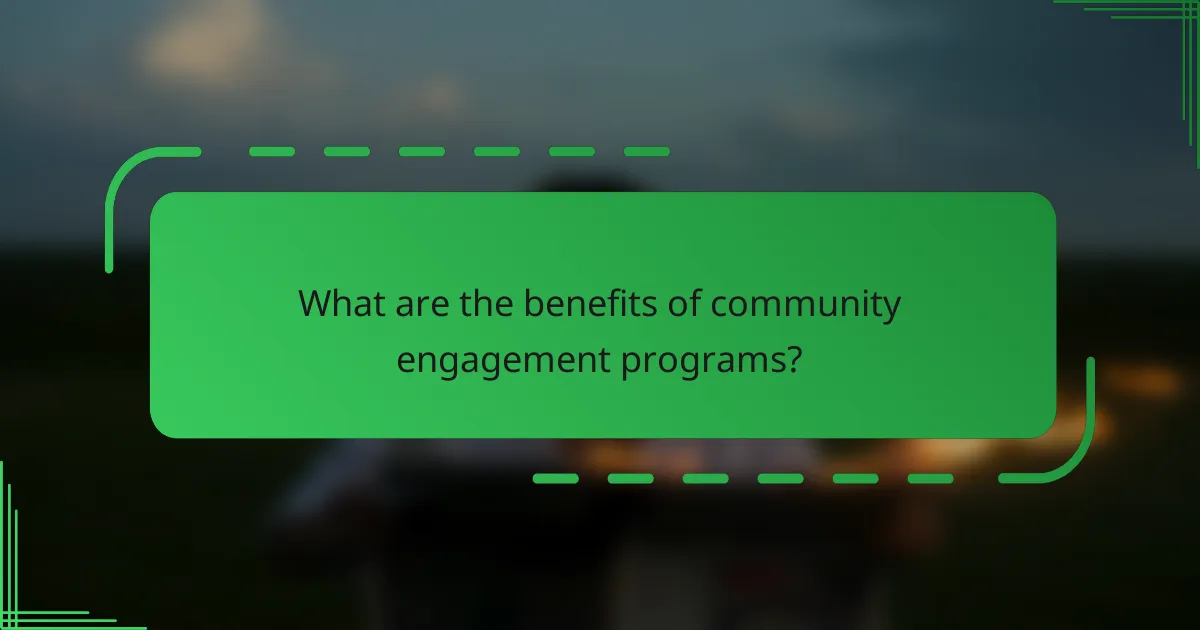
What are the benefits of community engagement programs?
Community engagement programs offer numerous benefits, including fostering trust, enhancing collaboration, improving public services, and strengthening community ties. These programs create a platform for dialogue and participation, leading to more effective solutions and a sense of belonging among residents.
Increased trust
Community engagement programs build trust between residents and local authorities. When community members are involved in decision-making processes, they feel valued and heard, which fosters a sense of transparency. This trust can lead to greater cooperation and a willingness to work together on local issues.
For example, regular town hall meetings can provide a space for residents to voice concerns and receive feedback from officials, reinforcing trust over time.
Enhanced collaboration
These programs encourage collaboration among various stakeholders, including government agencies, non-profits, and community groups. By bringing diverse perspectives together, community engagement can lead to innovative solutions that address complex social issues. Collaborative efforts often result in shared resources and knowledge, maximizing the impact of initiatives.
For instance, joint projects between local schools and community organizations can enhance educational opportunities while addressing community needs.
Improved public services
Community engagement programs can significantly enhance the quality of public services. When residents participate in discussions about their needs, local governments can tailor services to better meet those demands. This responsiveness can lead to more efficient use of resources and higher satisfaction among community members.
Surveys and feedback sessions are effective tools for gathering input on public services, allowing for continuous improvement based on community priorities.
Stronger community ties
Engagement initiatives help to strengthen community ties by fostering connections among residents. When individuals work together on projects or participate in local events, they build relationships that enhance social cohesion. Stronger ties can lead to a more resilient community that supports its members during challenges.
Examples include neighborhood clean-up days or cultural festivals that not only beautify the area but also promote a sense of belonging and pride among residents.

How can organizations measure community engagement outcomes?
Organizations can measure community engagement outcomes through various methods that provide insights into participation, satisfaction, and overall impact. Effective measurement combines quantitative data and qualitative feedback to create a comprehensive view of engagement levels.
Surveys and feedback
Surveys are a direct way to gather feedback from community members about their experiences and perceptions. Organizations can use online tools to distribute surveys, ensuring they are accessible and easy to complete. Aim for a response rate of at least 20-30% to obtain meaningful data.
Consider including a mix of multiple-choice questions for quantitative analysis and open-ended questions for qualitative insights. This combination allows for a deeper understanding of community sentiments and areas for improvement.
Participation metrics
Participation metrics track the number of individuals involved in community programs and events. This can include attendance figures, volunteer hours, and the number of active participants in discussions or activities. Regularly monitoring these metrics helps organizations assess engagement trends over time.
Establish benchmarks based on past events or similar organizations to evaluate success. For instance, if a community event typically attracts 100 attendees, aim to increase that number by 10-20% in subsequent years.
Social media analytics
Social media analytics provide valuable insights into community engagement by measuring interactions on platforms like Facebook, Twitter, and Instagram. Key metrics include likes, shares, comments, and overall reach, which indicate how well content resonates with the audience.
Utilize tools like Google Analytics or native social media insights to track these metrics. Set specific goals, such as increasing engagement by 15% over a quarter, to guide your social media strategy effectively.
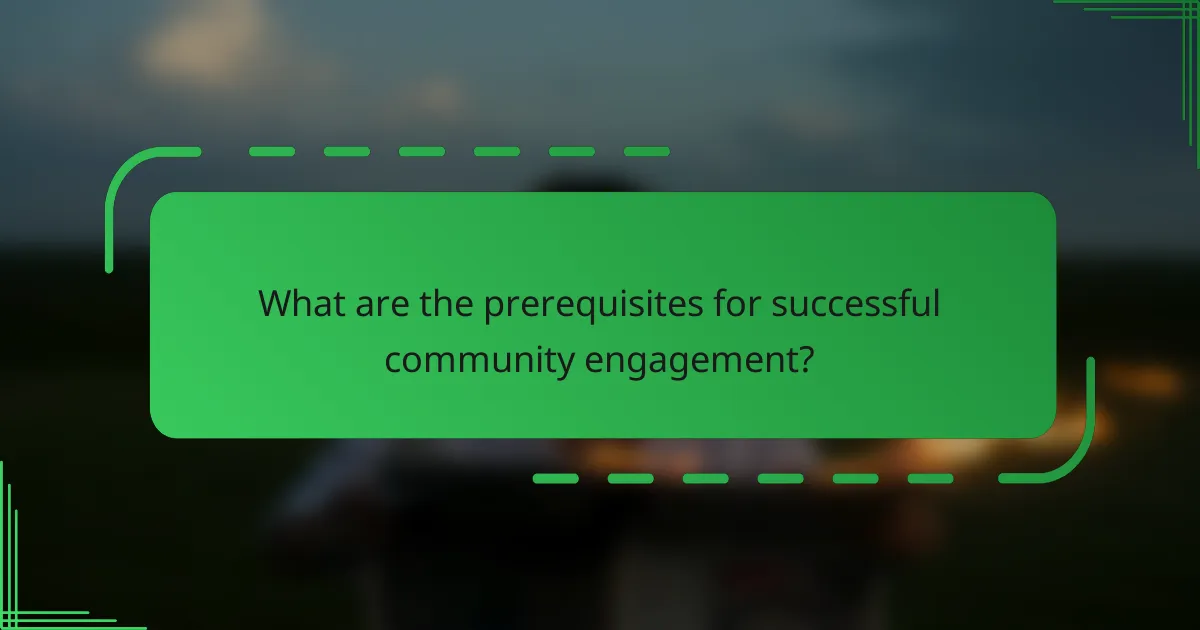
What are the prerequisites for successful community engagement?
Successful community engagement requires a clear understanding of the community’s needs and the active participation of stakeholders. Establishing a solid foundation through stakeholder identification, clear objectives, and adequate resource allocation is essential for effective engagement.
Stakeholder identification
Identifying stakeholders is crucial for successful community engagement. Stakeholders can include community members, local organizations, government agencies, and businesses. Engaging a diverse group ensures that various perspectives are considered, leading to more inclusive and effective programs.
To identify stakeholders, conduct a mapping exercise that outlines potential participants and their interests. This can involve surveys, interviews, or community meetings to gather insights on who should be involved. Aim for representation across different demographics to capture a wide range of views.
Clear objectives
Establishing clear objectives is vital for guiding community engagement efforts. Objectives should be specific, measurable, achievable, relevant, and time-bound (SMART). This clarity helps to align stakeholders and provides a framework for evaluating success.
When setting objectives, consider the community’s needs and the desired outcomes of the engagement. For example, if the goal is to improve local health services, objectives might include increasing awareness of available resources or enhancing access to healthcare facilities.
Resource allocation
Effective resource allocation is necessary to support community engagement initiatives. This includes budgeting for materials, personnel, and any necessary training. Ensure that resources are distributed equitably among stakeholders to foster collaboration and participation.
Consider leveraging local partnerships to maximize resources. For instance, collaborating with local businesses can provide financial support or in-kind contributions, such as venue space or promotional materials. Regularly assess resource needs and adjust allocations as the engagement progresses to maintain momentum and effectiveness.
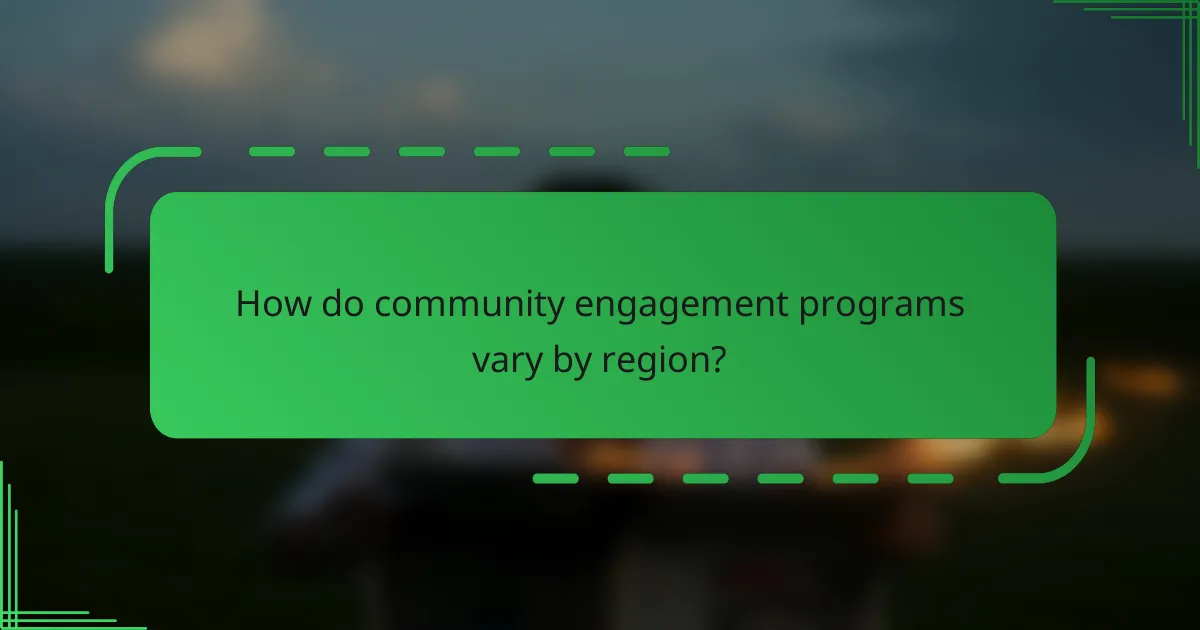
How do community engagement programs vary by region?
Community engagement programs differ significantly by region, influenced by local demographics, cultural values, and available resources. Understanding these variations is crucial for designing effective initiatives that resonate with specific communities.
Urban vs rural approaches
Urban community engagement programs often focus on diverse populations and may utilize technology and social media to facilitate participation. In contrast, rural approaches tend to emphasize face-to-face interactions and may rely on community gatherings or local events to foster engagement.
Urban areas might implement structured programs through nonprofits or government agencies, while rural communities often depend on informal networks and local leaders to mobilize residents. This distinction affects the types of activities and outreach strategies employed.
Regional cultural considerations
Cultural factors play a significant role in shaping community engagement programs. Regions with strong indigenous populations may prioritize traditional practices and values, integrating these into their engagement strategies to ensure inclusivity and respect.
In contrast, areas with a more homogeneous population might focus on specific interests or issues relevant to that group. Tailoring programs to reflect local customs and traditions enhances participation and fosters a sense of ownership among community members.
Local government policies
Local government policies can greatly influence the structure and funding of community engagement programs. Regions with supportive policies may provide grants or resources to encourage citizen involvement, while others may lack the necessary frameworks, limiting program effectiveness.
Understanding local regulations and available support is essential for organizations looking to implement engagement initiatives. Engaging with local government can also facilitate partnerships that enhance program reach and sustainability.


